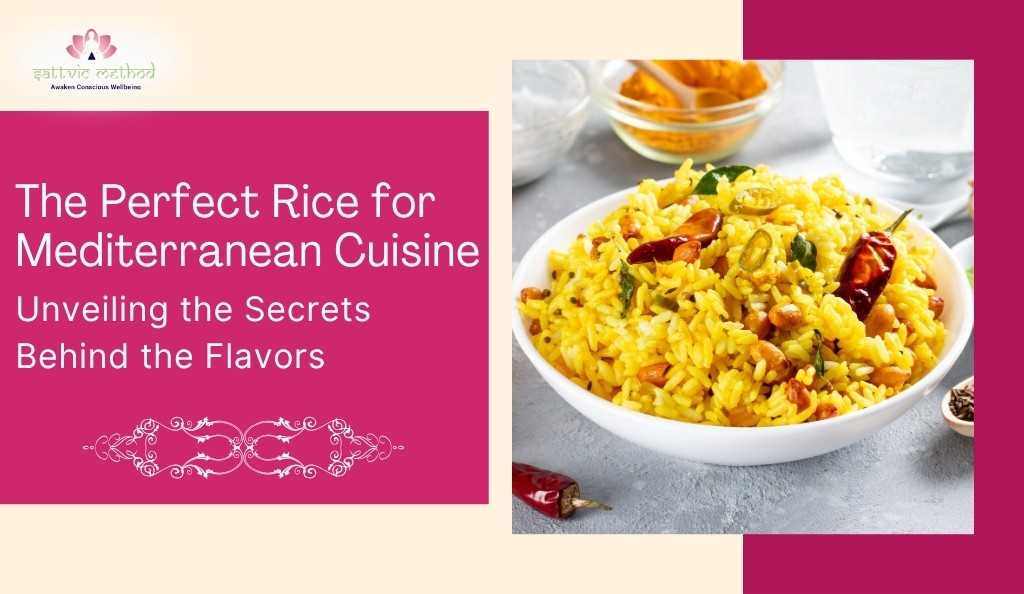Can You Enjoy Basmati Rice on a Mediterranean Diet? Discover the Surprising Truth!
When you think of the Mediterranean diet, vibrant veggies, flavorful olive oils, and fresh seafood often come to mind. But what about basmati rice? Traditionally associated with Indian cuisine, this fragrant grain may seem like an unlikely candidate for a Mediterranean plate. However, the truth might surprise you! Basmati rice can be a delightful addition to your Mediterranean meals, offering versatility and a unique texture that pairs beautifully with classic dishes. In this article, we’ll delve into the compatibility of basmati rice within the Mediterranean diet, exploring its nutritional benefits, culinary uses, and how you can enjoy this aromatic grain without compromising on the diet’s core principles. Ready to redefine your Mediterranean culinary experience? Let’s uncover the surprising truth about basmati rice and its place on your plate!
What is Basmati Rice?
Basmati rice is a type of long-grain rice known for its aromatic fragrance and distinct flavor. Originating from the Indian subcontinent, this rice has been cultivated for centuries in regions such as India and Pakistan. The word “basmati” comes from the Hindi word “basmatii,” which means “fragrant” or “aromatic.” This rice is unique not only for its scent but also for its long, slender grains that lengthen further when cooked, giving it a light, fluffy texture that sets it apart from other types of rice.
Basmati rice comes in both white and brown varieties, with the white version being more polished and having a milder flavor compared to its nuttier, whole-grain counterpart. The preparation of basmati rice involves rinsing and soaking the grains to remove excess starch, which allows the rice to cook evenly and reduces stickiness. This preparation method, coupled with its unique properties, makes basmati rice a favorite in many culinary traditions, particularly in Indian and Middle Eastern cuisines.
The popularity of basmati rice has transcended its regional origins, making its way into Western kitchens and global fusion dishes. Its versatility allows it to be used in a variety of recipes, ranging from simple steamed rice to complex biryanis and pilafs. Given its growing global appeal, it’s worth exploring how this delightful grain fits into different dietary frameworks, including the Mediterranean diet.
Nutritional Profile of Basmati Rice
Basmati rice is not just favored for its flavor and texture but also for its nutritional benefits. One cup of cooked basmati rice provides approximately 200 calories, making it a moderate energy source. It contains around 45 grams of carbohydrates, which are essential for providing energy to the body, and about 4 grams of protein, which is crucial for muscle repair and growth. The fat content in basmati rice is minimal, with less than a gram per serving, making it a low-fat option for those looking to maintain a healthy diet.
In addition to its macronutrient profile, basmati rice is also a good source of essential vitamins and minerals. It contains B vitamins such as B1 (thiamin) and B6, which are important for energy metabolism and brain function. Basmati rice also provides minerals like magnesium, phosphorus, and potassium, which play vital roles in bone health, muscle function, and maintaining proper fluid balance in the body. The brown variety of basmati rice is particularly rich in fiber, contributing to better digestive health and sustained energy release.
The glycemic index (GI) of basmati rice is another notable aspect, particularly for those monitoring their blood sugar levels. Basmati rice has a lower GI compared to other types of rice, meaning it causes a slower, more gradual increase in blood sugar levels. This makes it a suitable carbohydrate source for individuals with diabetes or those looking to manage their blood sugar levels more effectively. Overall, the nutritional profile of basmati rice shows that it is not only a flavorful addition to meals but also a beneficial component of a balanced diet.
How Basmati Rice Fits into the Mediterranean Diet
The Mediterranean diet is renowned for its emphasis on whole foods, healthy fats, and plant-based ingredients. It prioritizes vegetables, fruits, legumes, nuts, seeds, whole grains, and lean proteins such as fish and poultry. While rice is not traditionally a staple in Mediterranean cuisine, the diet is flexible and adaptable, allowing for the incorporation of various whole grains, including basmati rice, as part of a balanced meal plan.
Including basmati rice in the Mediterranean diet can be a seamless transition, as it complements many of the diet’s key components. For instance, basmati rice pairs wonderfully with vegetables, legumes, and lean proteins, creating nutrient-dense dishes that are both satisfying and healthful. The aromatic nature of basmati rice can also enhance the flavors of Mediterranean spices and herbs, such as oregano, thyme, and cilantro, making it a delightful addition to traditional Mediterranean recipes.
Moreover, the Mediterranean diet encourages the consumption of whole grains, and brown basmati rice fits this criterion perfectly. Its higher fiber content supports digestive health and provides a steady release of energy, aligning with the diet’s principles of sustained, balanced nutrition. By incorporating basmati rice into Mediterranean meals, you can enjoy the best of both worlds: the health benefits of the Mediterranean diet and the unique qualities of basmati rice.
Health Benefits of Including Basmati Rice
Incorporating basmati rice into your diet can offer a range of health benefits, making it a valuable addition to your culinary repertoire. One of the primary benefits is its positive impact on digestive health. The fiber content in brown basmati rice helps promote regular bowel movements and prevent constipation. A well-functioning digestive system is crucial for overall health and well-being, as it aids in the absorption of nutrients and the elimination of waste products.
Basmati rice is also beneficial for heart health. Its low-fat content, coupled with the presence of whole grains, can help reduce the risk of cardiovascular diseases. Whole grains like brown basmati rice contain antioxidants, vitamins, and minerals that support heart health by lowering cholesterol levels and improving blood pressure. Additionally, the lower glycemic index of basmati rice compared to other rice varieties means it has a gentler effect on blood sugar levels, which is beneficial for heart health and diabetes management.
Another significant health benefit of basmati rice is its potential to aid in weight management. The fiber in brown basmati rice can contribute to a feeling of fullness, reducing overall calorie intake and helping with weight control. Furthermore, the combination of carbohydrates and protein in basmati rice provides a balanced source of energy that can sustain you throughout the day, making it a great option for those looking to maintain a healthy weight without sacrificing nutrition.
Portion Control: Balancing Basmati Rice in Your Meals
While basmati rice offers numerous health benefits, portion control is essential to ensure that it fits well within a balanced diet. Eating large quantities of any carbohydrate-rich food can lead to an excess intake of calories and potentially disrupt blood sugar levels. Therefore, it’s important to be mindful of portion sizes when incorporating basmati rice into your meals.
A standard serving size of cooked basmati rice is about half a cup, which provides approximately 100 calories. This portion size allows you to enjoy the benefits of basmati rice without overloading on carbohydrates. Pairing this serving with a generous portion of vegetables, lean proteins, and healthy fats can create a well-rounded meal that aligns with the Mediterranean diet’s principles. Additionally, using basmati rice as a side dish rather than the main component of your meal can help maintain a balanced intake of nutrients.
Another effective strategy for portion control is to mix basmati rice with other whole grains or legumes. For example, combining basmati rice with quinoa, lentils, or chickpeas can enhance the nutritional profile of your meal while providing a variety of textures and flavors. This approach not only helps with portion control but also ensures that you are consuming a diverse range of nutrients essential for overall health.
Delicious Mediterranean Recipes Featuring Basmati Rice
One of the joys of cooking is experimenting with new ingredients and flavors, and basmati rice can add a delightful twist to traditional Mediterranean recipes. Here are a few delicious dishes that incorporate basmati rice, allowing you to enjoy this aromatic grain while staying true to the principles of the Mediterranean diet.
Mediterranean Basmati Rice Salad
This refreshing salad combines the fragrant qualities of basmati rice with the vibrant flavors of Mediterranean ingredients. Start by cooking one cup of basmati rice according to package instructions, then let it cool. In a large bowl, mix the cooked rice with chopped cucumber, cherry tomatoes, red onion, Kalamata olives, and crumbled feta cheese. For the dressing, whisk together olive oil, lemon juice, minced garlic, and a pinch of oregano. Toss the salad with the dressing and garnish with fresh parsley for a light, satisfying meal.
Basmati Rice Stuffed Bell Peppers
Stuffed bell peppers are a classic Mediterranean dish that can be elevated with the use of basmati rice. Begin by pre-cooking half a cup of basmati rice. Cut the tops off four bell peppers and remove the seeds. In a skillet, sauté chopped onion, garlic, and ground turkey or chicken until cooked through. Add diced tomatoes, cooked basmati rice, and a handful of chopped spinach. Season with salt, pepper, and a touch of cumin. Stuff the bell peppers with the rice mixture, place them in a baking dish, and bake at 375°F for 30-35 minutes. Serve with a side of tzatziki sauce for a flavorful, wholesome meal.
Herbed Basmati Rice Pilaf
A simple yet elegant herbed rice pilaf can be a perfect side dish for any Mediterranean meal. Cook one cup of basmati rice with two cups of vegetable broth instead of water for added flavor. In a separate pan, sauté finely chopped onions, garlic, and a mix of fresh herbs such as parsley, dill, and mint. Once the rice is cooked, fluff it with a fork and stir in the sautéed herb mixture. Add a squeeze of lemon juice and a sprinkle of toasted pine nuts for a delightful, aromatic pilaf that pairs beautifully with grilled fish or chicken.
Common Misconceptions About Carbs in the Mediterranean Diet
Carbohydrates often get a bad rap, especially in the context of weight loss and health-conscious eating. However, it’s important to understand that not all carbs are created equal. The Mediterranean diet, which is widely regarded as one of the healthiest eating patterns, includes a variety of carbohydrate-rich foods such as whole grains, legumes, fruits, and vegetables. These foods provide essential nutrients and energy, making them a crucial part of a balanced diet.
One common misconception is that all carbs lead to weight gain and should be avoided. In reality, the type and quality of carbohydrates matter significantly. Refined carbs like white bread and sugary snacks can indeed contribute to weight gain and health issues. However, whole grains like basmati rice, especially the brown variety, are nutrient-dense and provide fiber, vitamins, and minerals that support overall health. These complex carbs are digested more slowly, leading to sustained energy levels and better blood sugar control.
Another misconception is that the Mediterranean diet is low-carb. While it does prioritize healthy fats and lean proteins, it also includes a substantial amount of carbohydrates from whole grains, fruits, and legumes. The key is to choose high-quality, unrefined carbs and balance them with other nutrient-dense foods. Basmati rice, when consumed in appropriate portions and combined with a variety of other healthy foods, fits well within this framework and can be enjoyed as part of a balanced Mediterranean diet.
Tips for Choosing the Right Basmati Rice
Selecting the right basmati rice can enhance your culinary experience and ensure you are getting the best quality grain. Here are some tips to help you choose the perfect basmati rice for your Mediterranean-inspired dishes.
Firstly, consider the origin of the rice. Authentic basmati rice is grown in the Himalayan foothills of India and Pakistan. Look for packaging that indicates the rice’s origin, as this can be a good indicator of its authenticity and quality. Some brands may also carry geographical indication (GI) tags, which certify that the rice comes from a specific region known for producing high-quality basmati.
Next, pay attention to the age of the rice. Aged basmati rice is preferred by many chefs and home cooks because it has a lower moisture content, which results in a fluffier, more separated grain when cooked. Some brands specify the aging process on their packaging, often stating that the rice has been aged for one to two years. This aging process enhances the flavor and texture of the rice, making it a superior choice for your dishes.
Lastly, consider whether you want white or brown basmati rice. White basmati rice is polished and has a milder flavor, while brown basmati rice retains its outer bran layer, providing more fiber and a nuttier taste. Both types have their own unique qualities, so choose the one that best fits your dietary preferences and the specific recipe you are preparing. Keeping these tips in mind will help you select the highest quality basmati rice, ensuring delicious and nutritious meals.
Conclusion: Embracing Basmati Rice in a Healthy Lifestyle
As we’ve explored throughout this article, basmati rice can indeed be a delightful and healthy addition to the Mediterranean diet. Its unique flavor, versatile culinary applications, and impressive nutritional profile make it a valuable grain that complements the principles of this renowned eating pattern. By understanding how to balance basmati rice with other nutrient-dense foods and being mindful of portion sizes, you can enjoy its benefits without compromising on your health goals.
The Mediterranean diet’s flexibility allows for the inclusion of various whole grains, and basmati rice fits seamlessly into this framework. Whether you prefer the white or brown variety, incorporating this aromatic grain into your meals can enhance both flavor and nutrition. From refreshing salads to hearty stuffed peppers and elegant pilafs, the possibilities are endless when it comes to creating delicious Mediterranean dishes featuring basmati rice.
In conclusion, embracing basmati rice as part of a healthy lifestyle is not only possible but also highly enjoyable. By debunking common misconceptions about carbohydrates and making informed choices about the type and quality of rice you use, you can savor the unique qualities of basmati rice while staying true to the core principles of the Mediterranean diet. So, go ahead and redefine your culinary experience by welcoming basmati rice onto your Mediterranean plate, and discover the surprising truth about how this fragrant grain can elevate your meals.



